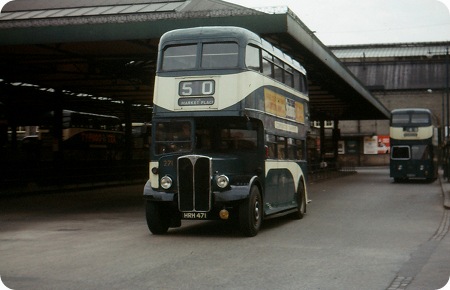Hull Corporation – AEC Regent III – HRH 471 – 471
Kingston upon Hull Corporation Transport
1947
AEC Regent III 0961/2
Weymann H32/26R
This is quite a nice shot of an AEC Regent III just departing Hull bus station on route 50, although only the locals would know were route 50 went as there is nothing on display for its final destination. This I think would of been rather an annoying system if you were a visitor to the area as the only thing you could be sure of is that if you wanted to go to the ‘Market Place’ you were safe on this bus because that is where it is going via. I think this practice was more prevalent for some operators of mainly town services, operators of longer distance services usually had larger destination blinds showing places they went via. If you know of any operators who had strange practices regarding destination information please leave a comment.
Yet another cracking photo! Service 50 went to the pier via the old town were it connected with the Humber Ferry service which ran across to New Holland on the south bank. The service ran until July 1981 when the Humber Bridge was opened.
Paul Morfitt
Doncaster Corporation were even better on destinations: no route numbers and the blind often just showed the final destination with a single via if needed to distinguish different routes there: in at least one case (Skellow via Owston Park), the bus didn’t really go to Skellow, but stopped short at Owston Park: the via was patched out much later. Well… if you didn’t know where the bus was going, everyone would tell you!
Joe
The blind showing, Market Place, was what was known as a "via" blind showing one major part of the route, as there was only space for one line of text, this type of blind appeared during the war, as the larger figures on the blinds were the primary means of identifying the route. All native "Hullensians" knew which route they required by the number. These blinds also appeared until the advent of the "G" registered series of Atlanteans, when a true destination blind appeared.
Keith Easton
Interesting, Keith. I wonder if this was part of the wartime initiative to confuse enemy infiltrators – especially relevant in east coast ports. As you will know signposts and railway station nameboards were removed for this reason.
Stephen Ford
Yes, Stephen, I’m sure that there was an element of what you said, but the main reason for using large numerals was more mundane. As you may be aware, during the wartime blackout conditions, bus operators were required to reduce the brilliance of external displays, consequently the size of the numerals was increased in order to improve visibility at night from a distance. For the same reason trolleybus blinds, which were in black on white, were replaced by black blinds with white numerals.
Keith Easton
03/02/11 – 17:11
On the subject of uninformative destinations Eastern Counties with their use of the word Service as a destination took some beating just as useless was the use of the company title as a destination also a popular ECOC wheeze! Of course the SBG were a breed apart with their extensive use of paper stickers and nothing but a number displayed on the destination screen!
Chris Hough
03/02/11 – 20:04
Lincolnshire Road Car and Western/Southern National were also adept in later years at wasting the "via" screen on the company name or "Service No."
Stephen Ford
04/01/18 – 06:51
Another quirk of the situation in Hull was that at the time Hull Corporation showed only a route number and ‘via’ blind, the local country operator, East Yorkshire, showed a destination and (usually) ‘via’, but no route number! So Hull folk had to be adaptable, especially if they lived on one of the several routes that were shared between the two operators.
George R
06/01/18 – 06:56
Until about 1936, Portsmouth Corporation had only a small number box and destination box. After this, a larger via box/ route indicator, plus destination box appeared on the vehicles. Sadly, the destination box displayed PORTSMOUTH CORPORATION and the destination was relegated to the via box with all the places the same size letters. Postwar, the destination box actually showed the destination! Let’s remember, too, that both route letters and numbers were used, but these changed according to the direction. 17/18 or A/B, the latter very unhelpful to holidaymakers at a seaside resort!
Christopher Hebbron
Quick links to the - Comments Page - Contact Page - Home Page
Comments - Please note: The comments facility is not currently available. Please see the home page for updates.
Please Note if you want to send a photograph with your comment please use the Contact Page by clicking here or send as an attachment via email.

